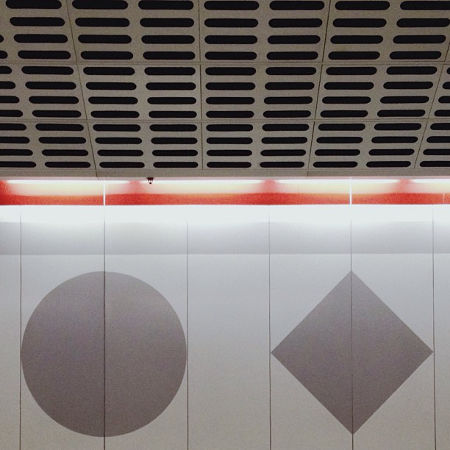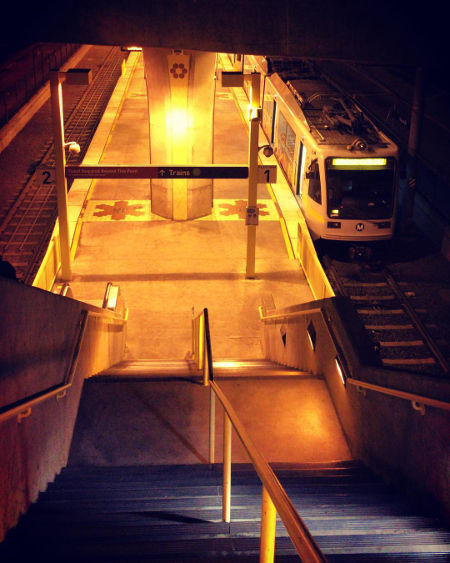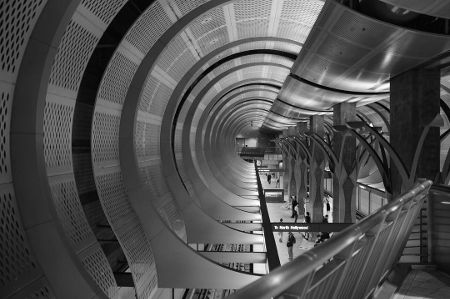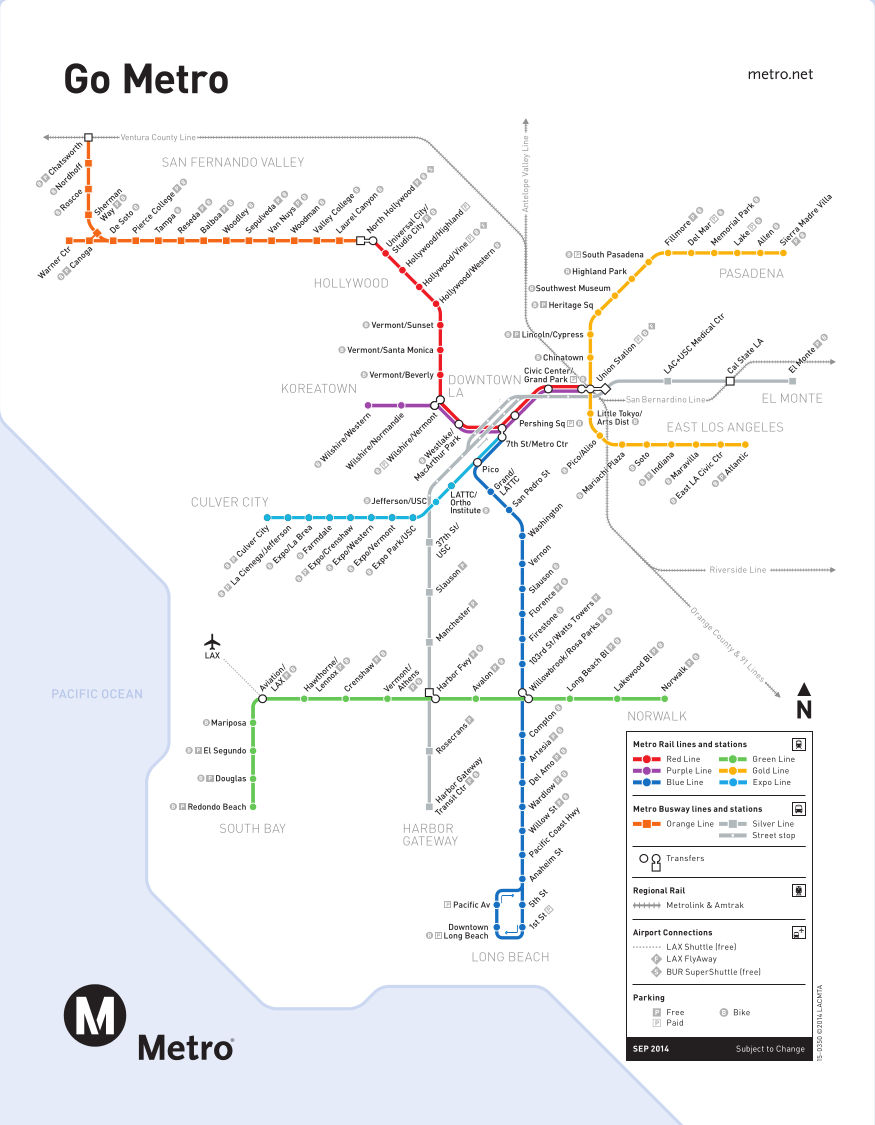Los Angeles Metro Rail is LA's system of train transportation. It opened in July 14, 1990. It has six lines: Blue, Red, Purple, Gold, Expo, and Green. Prices for passes range from $1 to $352 for different services (reduced rates are available.) It goes to places such as Hollywood and Disneyland. It connects to the airport via a shuttle towards the green line. Its lines will expand between 2019 and 2023. Transfers to other carriers of public transportation via EZ pass are also possible. The stations work every day from around 4:00 am until 1:00 am.
Metros in the United States: Los Angeles Metro Rail
Los Angeles is the second city with the largest population in the US, and is the most populated city in the State of California, with around 18 million people. The city is famous for being home of Hollywood, for being the scenario of many movies, TV shows, and music. Los Angeles is diverse in culture, as well as in science, technology, entertainment, and other areas.
History
California initially had a system of railways, owned by the companies Pacific Electric and Los Angeles Railway for over 50 years. However, profits declined, which resulted in trains being replaced by buses and the removal of a lot of railways in 1963. However, people in the 1970s wanted trains back, since traffic increased. The Red Line of Los Angeles Metro Rail was the first rail to be built for this metro system. The last Metro Rail line to be built was the Blue Line. Los Angeles Metro Rail was opened to the public in July 14, 1990.
How To Ride The Metro Rail Train In Los Angeles Video!
Lines and stations
Metro Rail is comprised of six lines: the Purple Line, the Blue Line, the Red Line, the Expo Line, the Gold Line, and the Green Line. Four of them use light rails, while the other two use heavy rails. The colors make it easy to differentiate each line. There are a total of 93 stations.
Purple Line
This line opened to the public in 2006. It is around 10 kilometers long, and uses heavy rails. It has 8 stations, which go from Wilshire/Western to Union Station. Stations: Pershing Square, Westlake/MacArthur Park, 7th Street/Metro Center, Wilshire/Vermont, Union Station, Wilshire/Normandie, Wilshire/Western, Civic Center/Grand Park
Blue Line
It opened to the public in 1990, and it is around 34 kilometers long. It uses light rails. It has 22 stations, which go from 7th Street/Metro Center to Downtown Long Beach. Stations: Grand/LATTC, San Pedro Street, 7th Street/Metro Center, Washington, Slauson, Vernon, Florence, 103rd Street/Watts Towers, Compton, Del Amo, Willow Street, Anaheim Street, 1st Street, Pacific Avenue, Downtown Long Beach, 5th Street, Pacific Coast Highway, Wardlow, Artesia, Willowbrook, Firestone, Pico
Red Line
It opened to the public in 1993. It is around 26 kilometers long. It uses heavy rails. It is comprised of 14 stations, which go from North Hollywood to Union Station. Stations: Pershing Square, Westlake/MacArthur Park, Civic center/Grand Park, Vermont/Santa Monica, Hollywood/Vine, Universal City/Studio City, North Hollywood, Hollywood/Highland, Hollywood/Western, Vermont/Beverly, Vermont/Sunset, Wilshire/Vermont, 7th Street/Metro Center, Union Station.
Expo Line
It opened to the public in 2012. Its railway uses light rails, and is around 24 kilometers long. It is comprised of 19 stations, which go from 7th Street/Metro Center to Santa Monica. Stations: LATTC/Ortho Institute, Expo/Western, Jefferson/USC, Expo/Crenshaw, La Cienega/Jefferson, Expo/Sepulveda, Culver City, Expo/Bundy, 17th Street/Santa Monica College, Downtown Santa Monica, 26th Street/Bergamot, Westwood/Rancho Park, Expo/La Brea, Palms, Farmdale, Expo/Vermont, Pico, Expo Park/USC, 7th Street/Metro Center.
Gold Line
It opened to the public in 2003. Its railway uses light rails, and is 50 kilometers long. It is comprised of 27 stations, which go from APU/Citrus College to Atlantic. Stations: Maravilta, Pico/Aliso, Indiana, Lincoln/Cypress, Little Tokyo/Arts District, Heritage Square, South Pasadena, Lake, Fillmore, Allen, Monrovia, APU/Citrus College, Duarte City of Hope, Del Mar, Azusa Downtown, Arcadia, Irwindale, Sierra Madre Villa, Memorial Park, Highland Park, Chinatown, Southwest Museum, Union Station, Mariachi Plaza, East Los Angeles Civic Center, Soto, Atlantic
Green Line
It opened to the public in 1995. Its railway uses light rails, and is around 31 kilometers long. It is comprised of 14 stations, which go from Redondo Beach to Norwalk. Stations: El Segundo, Crenshaw, Mariposa, Willowbrook, Vermont/Athens, Long Beach Boulevard, Norwalk, Avalon, Lakewood Boulevard, Harbor Freeway,wthorne/Lennox, Douglas, Aviation/LAX, Redondo Beach
 Los Angeles Metro Rail
Los Angeles Metro Rail
Rail connections
The Metro Rail lines connects to other carriers in Los Angeles. Some examples are:
- Greyhound
- La Puente
- El Segundo
- Commuter Express
- Baldwin Park
- Access Services
- Santa Barbara
Connection to the airport
Once you arrive to Los Angeles International Airport (LAX), look for a shuttle for the Green Line. Shuttles are available each 20 minutes from 5:00am to Midnight. The free trip will last 15 minutes. After arriving in Aviation/LAX Station, purchase a ticket, which costs $1.75. You also require to purchase a card from the vending machines. Use the escalator, and take the train to Norwalk Station. Then, you need to transfer to Willowbrook Station. Once in Willowbrook, take a train to the Blue Line.
Schedule, timetables, and hours of operations
Expo Line schedule
- Monday to Friday:
- 1) Eastbound to LA: Starts in Downtown Santa Monica Station at 4:40 am, and ends in 7th Street/Metro Center at 1:43 am.
- 2) Westbound to Santa Monica: Starts in 7th Street/Metro Center at 4:01 am, and ends in Downtown Santa Monica station at 1:41 am.
-
Saturdays, Sundays and Holidays:
- 1) Eastbound to LA: Starts in Downtown Santa Monica station at 4:42 am, and ends in 7th Street/Metro Center at 1:43 am.
- 2) Westbound to Santa Monica: Starts in 7th Street/Metro Center at 4:01 am, and ends in Downtown Santa Monica at 1:41 am.
Red Line schedule
-
Monday to Friday:
- 1) Eastbound: Starts in North Hollywood at 4:32 am, and ends in Union Station at 1:31 am. During Friday and Saturday nights, it starts at 1:22 am, and ends at 2:51 am.
- 2) Westbound: Starts in Union Station at 4:10 am, and ends in North Hollywood station at 1:31 am. During Friday and Saturday nights, it starts at 00:31 am, and ends at 2:50 am.
-
Saturdays, Sundays, and Holidays:
- 1) Westbound: Starts in Union Station at 4:10 am, and ends in North Hollywood station at 00:50 am.
- 2) Eastbound: Starts in North Hollywood station at 4:31 am, and ends in Union Station at 1:31 am.
Blue Line schedule
Monday to Friday:- 1) Northbound to LA: Starts in Downtown Long Beach at 4:45 am, and ends in 7th Street/Metro Center at 1:20 am.
- 2) Southbound to Long Beach: Starts in 7th Street/Metro Center at 4:47 am, and ends in Downtown Long Beach at 1:08 am.
-
Saturdays, Sundays, and Holidays:
- 1) Northbound to LA: Starts in Downtown Long Beach at 5:10 am, and ends in 7th Street/Metro Center at 1:18 am.
- 2) Southbound to Long Beach: Starts in 7th Street/Metro Center at 5:00 am, and ends in Downtown Long Beach at 00:59 am.

Gold Line schedule
- 1) Northbound: In Mondays through Fridays, it begins in Atlantic station at 4:20 am, and ends in APU/Citrus College at 2:04 am. In Saturdays, Sundays, and Holidays, it begins at 4:30 am, and ends at 2:00 am.
- 2) Southbound: In Mondays through Fridays, it begins in APU/Citrus College at 3:45 am, and ends in Atlantic station at 00:39 am. In Saturdays, Sundays, and Holidays, it begins at 4:42 am, and ends at 00:31 am.
Purple Line schedule
- 1) Eastbound: In Mondays through Fridays, it begins on Wilshire/Western at 4:41 am, and ends in Union Station at 1:31 am. In Friday and Saturday nights, it begins on 00:48 am, and ends in 2:51 am. In Saturdays, Sundays, and Holidays, service begins at 4:40 am, and ends at 1:31 am.
- 2) Westbound: In Mondays through Fridays, service begins in Union Station at 4:10 am, and ends in Wilshire/Western station at 00:24 am. In Friday and Saturday nights, service begins on 00:31 am, and ends at 2:24 am. In Saturdays, Sundays and Holidays, service begins at 4:10 am, and ends at 00:24 am.
Green Line schedule
- 1) Westbound: In Mondays through Fridays, service begins in Norwalk station at 4:01 am, and ends in Redondo Beach station at 1:24 am. In Saturday, Sundays, and Holidays, service begins at 4:04 am, and ends at 1:21 am.
- 2) Eastbound: In Mondays through Fridays, service begins in Redondo Beach station at 4:21 am, and ends in Norwalk station at 00:34 am. In Saturdays, Sundays, and Holidays, service begins at 4:31 am, and ends at 00:30 am.
Price, tickets, and cards
There are many services offered at different prices.
-Local fares: When you board the metro, you can pay by showing a pass or by using the TAP card, a card where you store money and tap it into a sensor to pay. TAP cards cost $1 if bought in a vending machine, and $2 if bought at shops. They require to be bought along with a ticket or by inserting money into the card. Senior citizens, disabled citizens and students have reduced rates on Metro Rail's services, but only if they use the TAP card. The card cannot be transferred to another person, and only one is offered per passenger. It can be used indefinitely. Boarding without using the card (nor paying with cash) will result in a $250 penalty.
The local fares can be divided into: 1-Way Trip, 7-Day Pass, 1-Day Pass, 30-Day Pass, Metro-to-Muni Transfer, and 30-Day and Zone 1 Pass.
- 1) 1-Way Trip ($1.75): With this pass, you have a one-way trip where you can transfer to other lines within two hours. The reduced rates are: Senior citizens (over 62 years old) and the disabled ($ 0.75,) college students ($1.75,) students K-12 ($1.)
- 2) 7-Day Pass ($25): Gives you trips for a week, until 3:00am of the 8th day after use. Transfers to Metro Rail's Silver Line and Metro Express Buses at extra charges.
- 3) 1-Day Pass ($7): Gives you one use for one day for all Metro Rail vehicles, until 3:00 am of the second day of use. Senior citizens only pay $2.50.
- 4) 30-Pass ($100): Gives you trips for 30 days, until 3:00 am of the 31st day after use. It requires extra charges if you transfer to the Silver Line or the Metro Express Buses. Reduced rates are: Senior citizens ($20,) college students ($43,) K-12 ($24.)
- 5) Metro-to-Muni Transfer ($0.50): Pass that lets you transfer from metro to bus within two hours. Senior citizens only pay $0.25.
- 6) 30-Day and Zone 1 Pass ($122): Works for 30 days for using every Metro Rail service.
Another product worth mentioning in local fares is Stored Value, which is inserting cash into the TAP card. The amount of cash that can be inserted are the following:
- Regular: $1.75 to $60.
- Senior citizens: $0.35 to $60.
- College students: $1.75 to $60.
- K-12: $1 to $60.
The next service is Silver Line/Metro Express. The Silver Line trains go from Harbor Gateway Transit Center to El Monte Station. The shuttles from Metro Express go from South Bay to Downtown Los Angeles. Extra charges apply. The prices to use the Silver Line/Metro Express are divided into: Ride Base Fare, 1-Way Trip, Premium Charge, and Express and Zone 1 Premium Charge.
- 1) Ride Base Fare ($2.50): Service given by paying the Silver Line with cash. Works for using this line, without being able to transfer. Extra charges are required if you want to use the Metro Express. Senior citizens only pay $1.35.
- 2) 1-Way Trip ($2.50): Pass that gives you a one-way trip, and allows you to transfer to other lines within two hours. Extra fares apply to transfer to Metro Express shuttles. Senior citizens only pay $1.35.
- 3) Premium Charge for 7-Day, 30-Day and EZ Transit Pass ($0.75): Additional charge needed to accept every Metro Pass without premium fares.
- 4) Express and Zone 1 Premium Charge ($0.75): Additional charge needed to travel on the highway. Senior citizens only pay $0.60.

Another pass offered is EZ Transit Pass, which is a month-by-month subscription that only works on TAP cards. It allows you to transfer to other public transportation services outside of Metro Rail, covering over 20 transit agencies.
1) EZ Transit Base Pass ($110): This pass works in every Metro Rail line, but extra fares apply to Silver Line, Non-Metro express shuttles, and Metro Express shuttles. Senior citizens only pay $42.
2) EZ Transit Pass Zones: Available in any Metro Rail vehicle, and lets you transfer to other public transportation carriers in 13 different zones. Discounts for senior citizens only apply if they have the Orange TAP card. This card can only be obtained by contacting Metro Rail's customer support offices. The price in each zone are the following:
- Zone 1: $132 ($51.50 for seniors.)
- Zone 2: $154 ($61 for seniors.)
- Zone 3: $174 ($70.50 for seniors.)
- Zone 4: $198 ($80 for seniors.)
- Zone 5: $220 ($89.50 for seniors.)
- Zone 6: $242 ($99 for seniors.)
- Zone 8: $286 ($118 for seniors.)
- Zone 9: $308.
- Zone 10: $330.
- Zone 11: $352.
- Zone 12: $152.
- Zone 13: $165.5.
- Zone 14: $175.
The public transportation agencies that accept the EZ Pass are:
- Beach Cities Transit
- Culvers City Bus
- Burbank Bus
- Foothill Transit
- Huntington Park Transit Unlimited
- Los Angeles Department of Transportation - DASH/Commuter Express
- Montebello Bus Lines
- LA World Airports/LAX Flyaway
- Norwalk Transit System
- Pasadena Transit
- Torrance Transit
- Santa Clarita Transit
- Santa Monica Big Blue Bus
- Palos Verdes Peninsula Transit Authority
- Metro
- Long Beach Transit
- GTrans (Gardena)
- LA County Department of Public Works
- Glendale Beeline
- City of Monterey Park Spirit Bus
- Baldwin Park Transit
- Carson Circuit
- Antelope Valley Transportation Authority
Rules in LA Metro Rail
- Animals are not allowed in the metro, unless they are inside cages or they are guide dogs.
- Bikes, skates, and other non-fuel-powered small wheeled vehicles can be carried inside the metro. Bikes over six feet long, and fuel-powered bikes are not allowed.
- Vehicles can be parked at parking facilities, but must not exceed time allowed for parking.
- Photos are allowed for non-commercial purposes.
- Proof of payment can be requested at random.
- Large sized strollers are not allowed, and smaller strollers should be folded.
- Eating, smoking, and drinking alcohol is only allowed in designated areas.
Future expansions
In 2023, the Purple Line will add new stations in the following areas: Wilshire/La Brea, Wilshire/Farfax, and Wilshire/Cienega. The Green Line will also be expanded to include new stations in Aviation/Century in 2019, and in Aviation/96th in 2021.
LA Metro Rail Tips
There are guided tours available for the Purple, Red, and Expo lines. The tours explain how to buy a TAP card, how to transfer to other lines, how to locate connections, and how to use the mobile app. The tours are free and you can sign up to them online. Parking is available at every line. There are free and paid parking spots. Reserved parking lasts until 10:30 am, and is available at 11 locations.
Los Angeles Metro Map
Fun Facts
One percent of Metro Rail's construction costs were used for paying the art pieces displayed inside the stations, which were made by over 200 artists.
In one of Red Line's stations, there are sculptures made out movie projectors of Hollywood from the 1930s. In the same station, the ceiling is decorated with movie reels. Some movies were filmed in Metro Rail's stations, some of which were: Red Line, Predator 2, While the City Sleeps, Collateral, Speed, among others.
The beach can be reached by going to Blue Line’s 1st Street station.
Over 1900 fossils from around 15 million years ago were found in North Hollywood and Wilshire/Vermont stations. The fossils included bones of animals and fossilized plants.
Nearby attractions
Los Angeles International Airport (LAX) will be used as a reference to get to these destinations using Metro Rail.
- 1) Disneyland Resort: Take a Lot G shuttle from the airport to the Green Line. Then, take a train from Redondo Beach station to Norwalk station. Then, take a Metro Express Line 460 shuttle towards Disneyland. The whole trip lasts from two to three hours. This is the best family friendly vacation place in Los Angeles. Among the activities available are enjoying the Disney themed rides, to visiting the hotels and restaurants.
- 2) Universal Studios Hollywood: Take a shuttle from the airport to the Red Line towards Universal City Station. From this station, take a bus towards Universal Studios. It is a movie studio, with roller coasters and park rides based on Hollywood movies.
- 3) Hollywood: From the LAX station, take a shuttle from Flyaway Union Station towards North Patsaouras Plaza. Then, take a train in the Red Line Union Station to North Hollywood station. The whole trip lasts from 30 minutes to one hour. You can enjoy part of movie history, as well as landmarks such as the Walk of Fame.
- 4) Griffith Park and Griffith Observatory: Take a shuttle from the airport towards Union Station. From there, ride on the Red Line towards Pershing Square station. Next, ride on a Metro Local Line 96 train from Olive Street/5th to Griffith Park. This is the largest park in Los Angeles, and is free to the public.
- 5) Santa Monica: From the airport, take a Lot C shuttle to LAX City Bus Center. Take a Santa Monica Rapid R 3 bus from Bus Center to 4th Street/Santa Monica Boulevard (EZ Pass accepted for the transfer.) There is a beach, there are shopping centers, and a Ferris wheel.
- 6) Getty Center: From the airport, take a shuttle towards Wilshire Boulevard/Gayley Avenue Southwest. Take a Metro Rapid Line 734 train from Westwood Boulevard/Lindbrook Drive to Sepulveda Boulevard/Getty Center Drive (EZ Pass is accepted for the connection). The trip lasts around an hour. This is a famous museum that attracts over a million tourists with its collection of art from many countries.
Metro map of Los Angeles
Map via media.metro.netSee map full resolution. It may take a little bit to load.
Los Angeles Metro Rail map
- Also Known As: Metro Rail
- Passengers/Day 308000
- Fares: 1.91
- 24h operation: No
- Air Conditioning: Yes
- Walk between platforms: No
- Driverless trains: No
- Screen Doors Platforms: No
- Operator: Los Angeles County Metropolitan Transportation Authority (LACMTA)
- $1
- Los Angeles Metro Official Website
Help us
If you consider that the information we provide is wrong, not accurated, outdated, translation contains errors, and you would like to help us to improve the file...you can contact us here.
Feel free to contact us if you dont find the system you're looking for and we'll add it as soon as we can!
Thank you very much!










